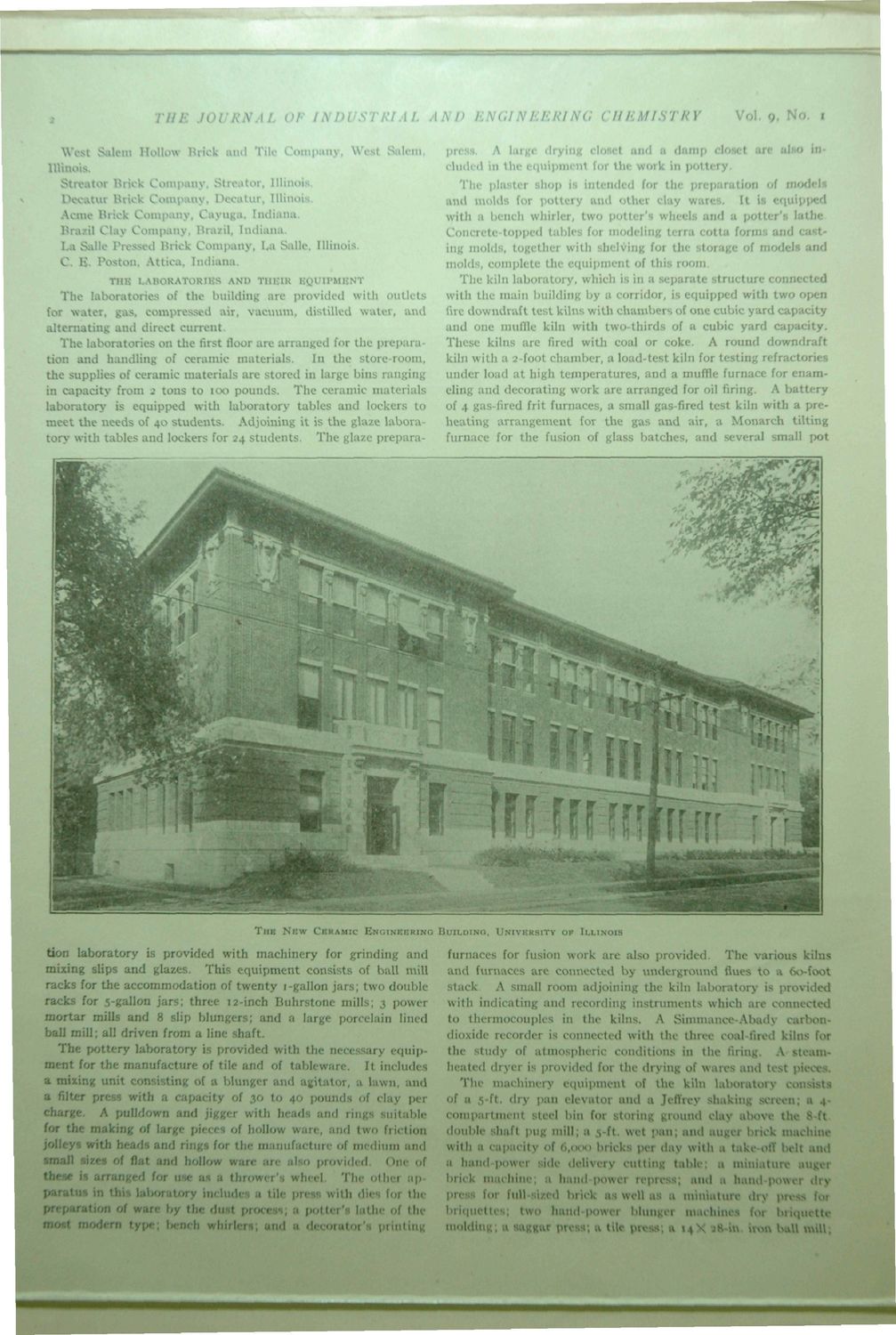| |
| |
Caption: Dedication - Ceramic Engineering - Journal Article
This is a reduced-resolution page image for fast online browsing.

EXTRACTED TEXT FROM PAGE:
THE JOURNAL OF INDUSTRIAL West Salem Hollow Brick and Tile Company, West Salem, Illinois. Streator Brick Company, Streator, Illinois. Decatur Bride Company, Decatur, Illinois. Acme Brick Company, Cayuga. Indiana, Brazil Clay Company, Brazil, Indiana. La Salic Pressed Brick Company, Ui Salle. Illinois. C. E. Poston, Attica, Indiana. THB LABORATORIES AND Tin; IK EQUIPMENT The laboratories of the building are provided with outlets for water, gas, compressed air, vacuum, distilled water, and alternating and direct current. The laboratories on the first floor arc arranged for the preparation and handling of ceramic materials. In the store-room, the supplies of ceramic materials are stored in large bins ranging in capacity from 2 tons to 100 pounds. The ceramic materials laboratory is equipped with laboratory tables and lockers to meet the needs of 40 students. Adjoining it is the glaze laboratory with tables and lockers for 24 students. The glaze prepara- AND ENGINEERING CHEMISTRY Vol. 9, No. 1 press. A large drying closet and a damp closet are also included in the equipment for the work in pottery. The plaster shop is intended for the preparation of models and molds for pottery and other clay wares. It is equipped with a bench wbirler, two potter's wheels and a potter's lathe Concrete-topped tables for modeling terra cotta forms and casting molds, together with shelving for the storage of models and molds, complete the equipment of this room. The kiln laboratory, which is in a separate structure connected with the main building by a corridor, is equipped with two open fire downdraft test kilns with chambers of one cubic yard capacity and one muflle kiln with two-thirds of a cubic yard capacity. These kilns arc fired with coal or coke. A round downdraft kiln with a 2-foot chamber, a load-test kiln for testing refractories under load at high temperatures, and a muffle furnace for enameling and decorating work are arranged for oil firing. A battery of 4 gas-fired frit furnaces, a small gas-fired test kiln with a preheating arrangement for the gas and air, a Monarch tilting furnace for the fusion of glass batches, and several small pot THE NEW CERAMIC ENGINEERING BUILDING, UNIVERSITY or ILLINOIS tion laboratory is provided with machinery for grinding and mixing slips and glazes. This equipment consists of ball mill racks for the accommodation of twenty 1 -gallon jars; two double racks for 5-gallon jars; three 12-inch Buhrstonc mills; 3 power mortar mills and 8 slip blungers; and a large porcelain lined ball mill; all driven from a line shaft. The pottery laboratory is provided with the necessary equipment for the manufacture of tile and of tableware. It includes a mixing unit consisting of a blunger and agitator, a lawn, and a filter press with a capacity of 30 to 40 pounds of clay per charge. A pulldown and jigger with heads and rings suitable for the making of large pieces of hollow ware, and two friction jolleys with heads and rings for the manufacture of medium and small sizes of flat and hollow ware are also provided. One of these is arranged for use as a thrower's wheel. The other apparatus In this laboratory includes a tile press with dies for the preparation of ware by the dust process; a potter's lathe of the mo*t modem type; bench winders; and a decorator's printing furnaces for fusion work are also provided. The various kilns and furnaces are connected by underground flues to a 60-foot stuck. A small room adjoining the kiln laboratory is provided with indicating and recording instruments which ore connected to thermocouples in the kilns. A Simmance-Abady carbon* dioxide recorder is connected with the three coal-fired kilns for the study of atmospheric conditions in the firing. A' steam* heated dryer is provided for the drying of wares and test pieces. The machinery equipment of the kiln laboratory consists of a 5-ft. dry pan elevator and a Jeffrey shaking screen; a 4* compartment steel bin for storing ground clay above the S-ft. double shaft pug mill; a 5-ft. wet pan; and auger brick machine with a capacity of 6,000 bricks per day with a take-oft belt and a hand-power side delivery cutting table; u miniature uu^er brick machine; a hand-power repress; and a htmd-powcr dry press for full-sized brick as well as u miniature dry press for briquettes; two hand-power blunger machines for briquette molding; a snggnr press; a tile press; a 14X a8-ln. Iron hull mill:
| |